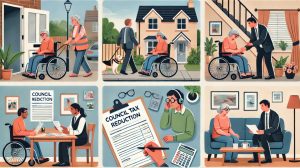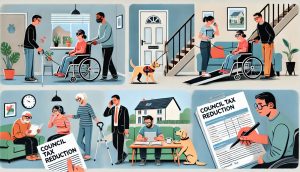Managing finances can be challenging, especially for households where someone is living with a disability. Fortunately, in the UK, financial relief is available through council tax reductions for qualifying individuals.
These reductions are designed to help alleviate some of the additional costs associated with modifying homes to accommodate a disabled resident. However, navigating through the eligibility criteria and understanding the application process can be a complex task.
In this guide, I will walk you through what disabilities qualify for council tax reduction, how the system works, and the steps you can take to benefit from it.
What Is Council Tax Reduction for Disabled People?

Council tax reduction for disabled individuals is a scheme introduced by local authorities to provide financial assistance to households that have made necessary modifications to their homes to accommodate the needs of a disabled resident.
The goal of this scheme is to lower the council tax burden on these households, recognising that they often require more living space or specific adaptations to their homes.
The reduction can be applied in a couple of ways:
- Band Reduction: Your property’s council tax band could be reduced by one band. For instance, if your home is in Band C, it may be moved down to Band B, thereby lowering the amount of council tax you pay.
- Fixed Percentage Discount: In some cases, you may qualify for a fixed percentage reduction if you meet the necessary criteria.
Local authorities are responsible for administering this scheme. They assess applications to ensure that the disabled individual qualifies based on their condition and that the adaptations made to the home are substantial and necessary for daily living.
How Local Authorities Manage Reductions?
Every local council has its own specific processes and guidelines for managing council tax reductions for disabled individuals.
However, most councils follow a general structure: they require proof of disability, verification of the home adaptations made, and sometimes an inspection of the property. Upon approval, the council applies the reduction either by lowering the council tax band or by offering a specific discount.
Who Is Eligible for Disabled Council Tax Reduction?

Eligibility for a council tax reduction is based on both the nature of the disability and the modifications made to the home. Typically, the reduction is only available if someone in the household is considered “substantially and permanently” disabled. This includes individuals with both physical and mental impairments, but the exact criteria can vary by local authority.
Disabilities That May Qualify
While councils may have slightly different qualifying criteria, certain types of disabilities are almost always eligible for council tax reduction:
- Severe Mental Impairment (SMI): This covers individuals who suffer from conditions such as Alzheimer’s disease, dementia, or other forms of severe cognitive impairment that significantly affect daily life. If a person has been diagnosed with an SMI, they may qualify for a full exemption from council tax. To qualify, they must be certified by a doctor and also be entitled to certain benefits, such as Disability Living Allowance (DLA) or Personal Independence Payment (PIP).
- Physical Disabilities: People who have mobility impairments that require the use of wheelchairs inside the home, or who need substantial physical adaptations to their living environment, may also qualify. This includes individuals with conditions such as paralysis, multiple sclerosis (MS), and severe arthritis. If a person’s disability necessitates changes to the structure or layout of the home, such as the installation of ramps, stairlifts, or accessible bathrooms, they are likely eligible for a council tax reduction.
Home Adaptations Required for Qualification
In addition to having a qualifying disability, the home in which the disabled individual resides must have been adapted to suit their specific needs.
These adaptations are assessed by the local council to ensure they meet the criteria for a reduction. Common examples of qualifying adaptations include:
- An Extra Bathroom or Kitchen: If an additional bathroom or kitchen has been added to the home to accommodate the disabled person’s needs, this could qualify the property for a council tax reduction. This might involve a bathroom with accessibility features like grab rails, a roll-in shower, or a lower sink and counter height for wheelchair use.
- Space for Wheelchair Use Inside the Home: If the disabled individual uses a wheelchair, the home must be adapted for easy movement within the living areas. This could involve widening doorways, removing steps, or installing ramps. If wheelchair use is necessary within the home, this is a strong indicator that the household qualifies for a reduction.
- A Room Predominantly Used by the Disabled Person: The home must include a room, other than a kitchen, bathroom, or toilet, that is primarily used by the disabled individual for treatment or therapy. For example, a room might be used for medical equipment like oxygen tanks or mobility devices, or as a quiet space for therapy.
In each case, the council will need to verify that these adaptations are essential and that they improve the quality of life for the disabled person in question.
How Does the Disabled Band Reduction Scheme Work?
The Disabled Band Reduction Scheme is a key component of the council tax reduction programme. It’s specifically designed for households where someone’s disability requires the home to be larger or to have specific adaptations that wouldn’t be needed otherwise.
The scheme works by lowering the council tax band of a property, which in turn reduces the amount of tax payable.
How the Band Reduction Works?
Every property in the UK is assigned to a council tax band, ranging from Band A (the lowest) to Band H (the highest), based on the estimated market value of the home.
If you qualify for the Disabled Band Reduction Scheme, your property may be reassessed, and its council tax band will be reduced by one band. For example:
- A Band D property would be moved down to Band C.
- A Band B property would move down to Band A.
For properties already in Band A, the scheme still provides a reduction. Instead of moving to a lower band (since Band A is the lowest), households will receive a discount equivalent to one-sixth of the Band A rate.
Example Scenario:
Consider a family living in a Band D property. The house has been adapted to include a ground-floor bedroom and a fully accessible bathroom for a disabled family member who uses a wheelchair.
Because of these adaptations, the family may apply for a reduction, and the council could move the property to Band C, resulting in a lower council tax bill.
How Do I Apply for Council Tax Reduction?

Applying for council tax reduction is a relatively straightforward process, but it does require attention to detail and the submission of supporting evidence.
The first step is to contact your local council to express your interest in applying for a reduction under the Disabled Band Reduction Scheme or any other related discount.
Steps for Applying
- Contact Your Local Council: Visit your local council’s website or give them a call to inquire about the application process for council tax reduction. They will provide the relevant forms and guidance on how to proceed.
- Prepare the Necessary Documentation: To apply, you will need to provide proof of the disability and the adaptations made to the property. This includes:
- A certificate or letter from a doctor or healthcare provider confirming the nature of the disability.
- Receipts, photos, or reports detailing the home adaptations (e.g., installing ramps, adding a bathroom).
- Complete the Application Form: Fill out the application form provided by your local council. Be sure to include all the required information about the disabled person’s condition and the adaptations that have been made to the home.
- Arrange for an Inspection (if required): Some councils may send a representative to your property to verify the adaptations. This inspection ensures that the home has been modified in a way that supports the disabled person’s needs.
- Await the Council’s Decision: Once you have submitted the application and provided all necessary documentation, the council will review your case. This process can take several weeks, depending on the council’s workload and the complexity of your application.
Are There Other Exemptions or Discounts for Disabled Individuals?
Aside from the Disabled Band Reduction Scheme, other exemptions and discounts are available for disabled individuals and their carers.
Severe Mental Impairment (SMI) Exemption
Individuals with severe mental impairments, such as dementia, Alzheimer’s, or severe learning disabilities, may be eligible for a full council tax exemption.
This applies when the disabled person either lives alone or only with others who are also exempt from council tax. To qualify, the individual must meet the following criteria:
- They must have been certified by a doctor as having a severe mental impairment.
- They must be entitled to specific disability benefits, such as Attendance Allowance or Personal Independence Payment (PIP).
Discounts for Carers
If you live with someone who is disabled and provide care for them, you may also be eligible for a council tax discount. To qualify for this discount, the carer must:
- Live in the same property as the disabled person.
- Provide at least 35 hours of care per week.
- Not be the spouse, partner, or parent of the disabled individual.
Carers who meet these criteria may be entitled to a 25% discount on their council tax bill.
Conclusion
Council tax reductions for disabled individuals provide valuable financial relief. Whether through the Disabled Band Reduction Scheme or other discounts, it’s essential to understand the eligibility criteria and the application process.
If you or someone in your household is disabled, you could be entitled to a reduction. Don’t hesitate to contact your local council to explore your options and ensure you’re getting the financial support you deserve.
What Are the FAQs About Disability Council Tax Reduction?
How do I know if I qualify for a council tax reduction?
To qualify, you or someone in your household must have a substantial disability that requires home adaptations. Check with your local council and provide medical evidence to confirm your eligibility.
What adaptations to my home make me eligible for a tax reduction?
Adaptations like adding an extra bathroom, kitchen, or widening doorways for wheelchair access can make you eligible. The changes must be necessary due to the disabled person’s needs.
Can I apply for a reduction if someone in my household is disabled?
Yes, you can apply if a person living in your home is disabled and the home has been adapted to meet their needs. The reduction applies to the property, not the individual.
Do carers qualify for council tax discounts?
Carers providing substantial care (at least 35 hours per week) to a disabled individual may qualify for a discount if they live in the same property.
What is the difference between a reduction and an exemption?
A reduction lowers the amount of council tax you pay by moving your property into a lower band. An exemption removes the requirement to pay council tax altogether, such as in the case of severe mental impairment.
How long does it take to process my council tax reduction application?
Processing times vary depending on the local council, but it typically takes between 4 to 8 weeks after submitting your application and supporting documents.
Is there a council tax reduction for mental health disabilities?
Yes, individuals with severe mental impairments, such as dementia or other mental health conditions, may qualify for a council tax reduction or exemption.






